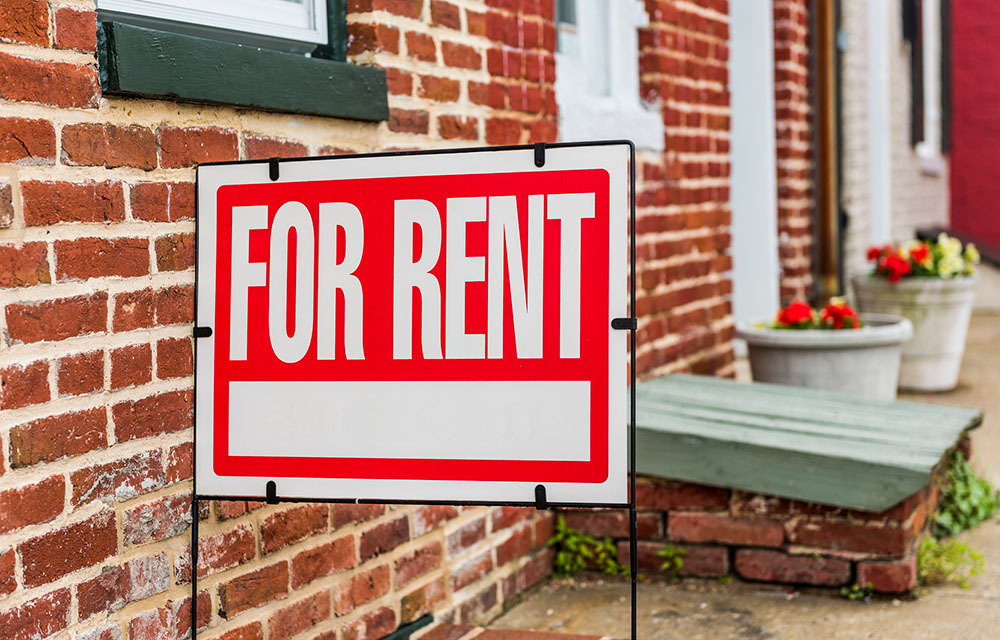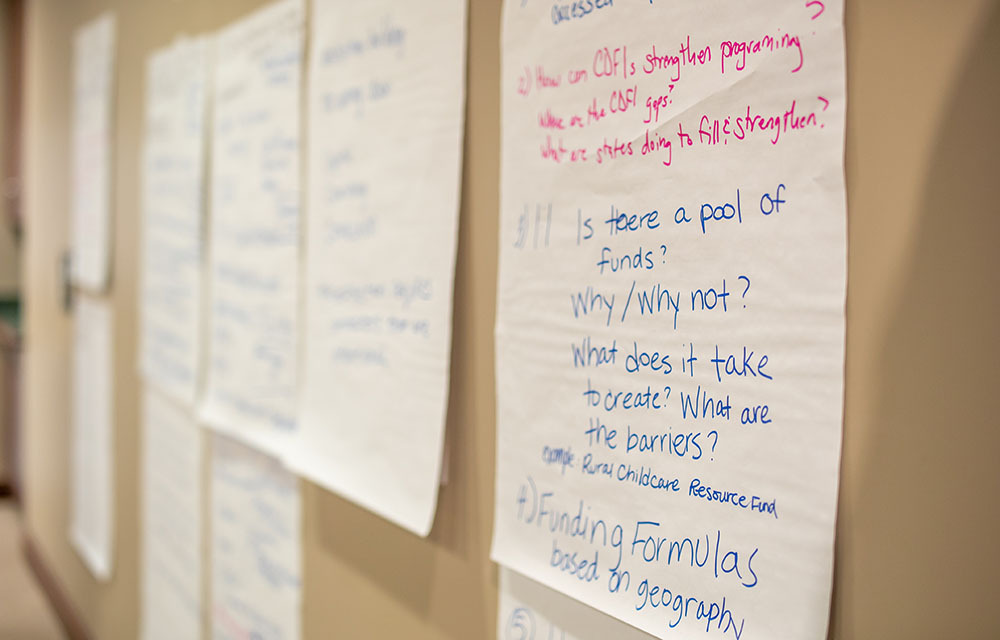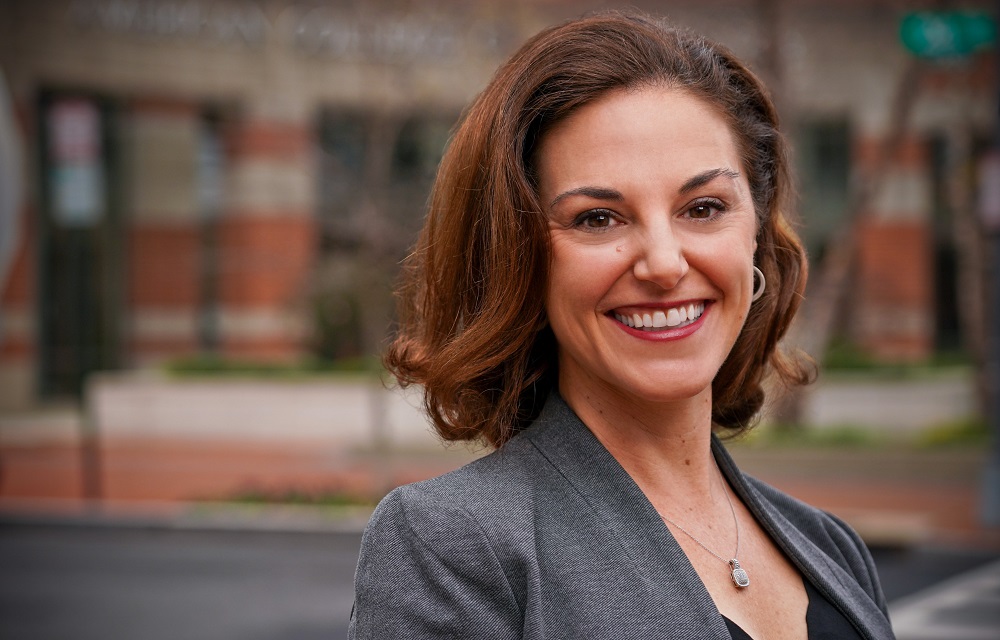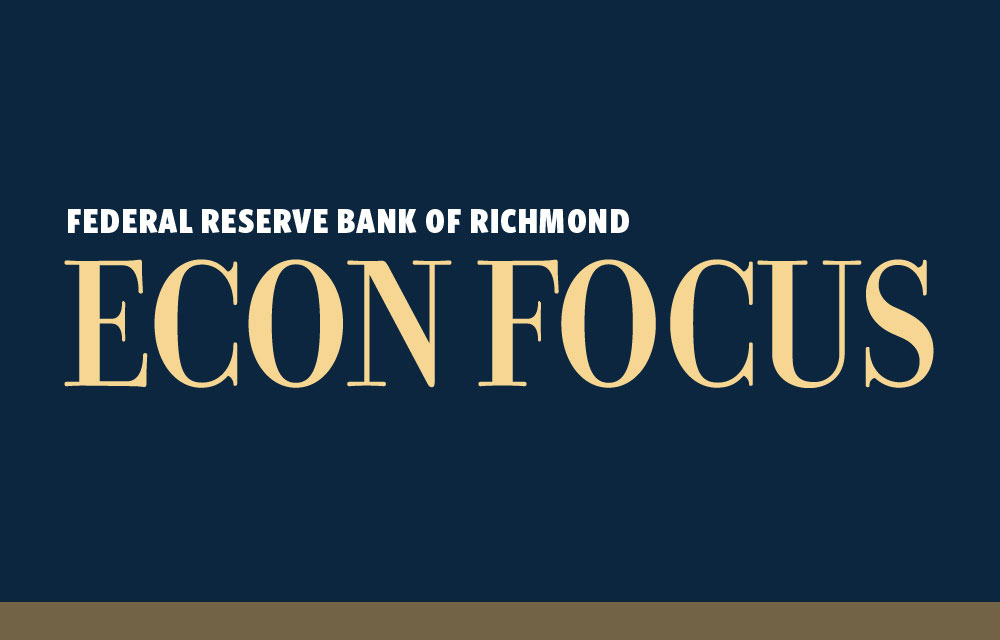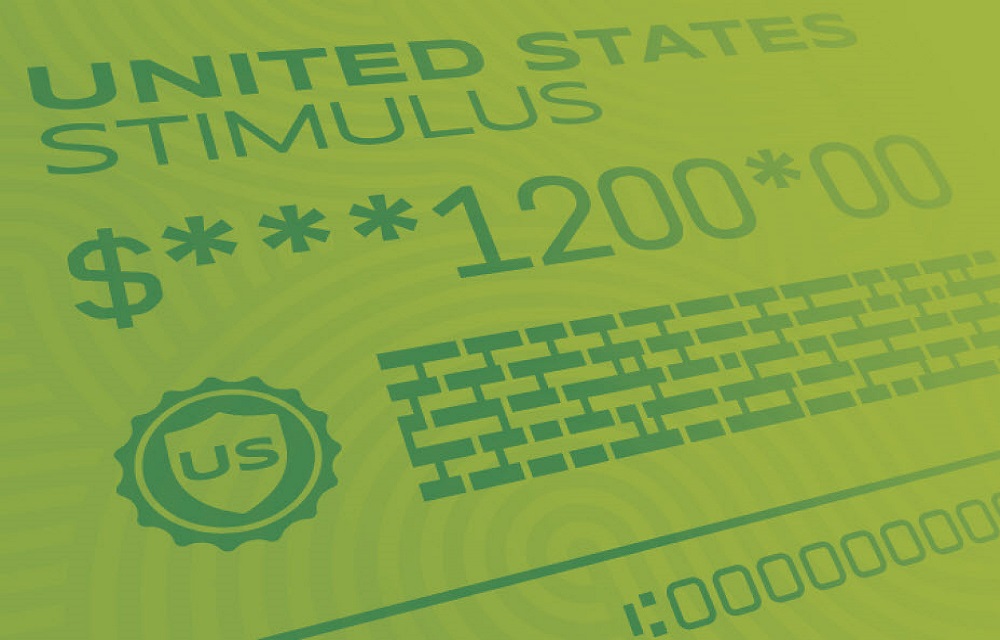When a primary worker' income drops unexpectedly, spousal labor supply and earnings increase to compensate, especially in young households with limited financial assets.
Household and Consumer Finance

Learn more about the borrowing, saving and investment choices that people make over time.
 Updating Results
Updating Results
Why might consumer demand be slowing? This post explores PCE spending, including in the nonprofit sector.
John O'Trakoun
Senior Policy Economist
Doug Borland and Stephanie Mehlhouse share insights from the 2024 Survey and Diary of Consumer Payment Choice, which was compiled by the Federal Reserve to provide a comprehensive picture of payment preferences and behavior in the United States. Borland is assistant vice president of cash services and Mehlhouse is a senior cash manager, both based at the Charlotte office of the Federal Reserve Bank of Richmond.
This week's post explores some features of the latest PCE report for evidence that this payback effect has contributed to today's slow spending rates.
New ideas developed in the second half of the 20th century built the financial world around us and remain impactful today.
Fatimah Khan
A "rounding tax" could affect consumers, especially if attention turns to phasing out the nickel as well.
Zhu Wang and Russell Wong
Many Fifth District communities rely on government transfer payments for a sizable share of personal income, but the amount varies, particularly between rural and urban areas.
Bethany Greene
Regional Economist
Inflation expectations are on the rise at a steeper rate than in 2018, but it's still unclear if household sentiment will have an impact on consumer spending.
John O'Trakoun
Senior Policy Economist
Job Boerma shares a model for how poor mental health affects the economic decisions of consumers and the economy as a whole. Boerma, an assistant professor in economics at the University of Wisconsin-Madison, presented his research at a recent CORE Week at the Richmond Fed.
What impact could "buy now, pay later" have on other payment forms and on financial stability as a whole?
Exploring the breadth of consumer spending through a diffusion index shows the U.S. consumer is likely to have entered 2025 in robust shape.
A fast-growing alternative to credit cards encourages consumers to spend and borrow more.
Avani Pradhan
White households cover more medical expenses out of pocket or through payors such as private insurance, while Black and Hispanic households have larger shares covered by Medicaid.
Karolos Arapakis, Erin Henry, John Bailey Jones and Nathan Robino
Customer spending in the Fifth District has been on a decline according to results from the Richmond Fed's business surveys. This pullback was especially true among lower-income individuals.
In this week's post, we look at some of the survey evidence that consumers are starting to pull back on spending.
John O'Trakoun
Senior Policy Economist
Many Americans have surprisingly little set aside for retirement. Why, and what can be done to help more Americans save and retire with financial security?
Andy Bauer and Renee Haltom talk about why consumers and businesses are telling a different story about the economy than the data suggests. They also discuss how economists reconcile such differences between sentiment and data. Bauer and Haltom are regional executives at the Richmond Fed.
The stock market is way up, and households know it. A consumption-supporting wealth effect, an overvalued stock market, and expecting strong future output growth are three possible causes.
John O'Trakoun
Senior Policy Economist
Among women born 1920-1949, family income is higher for those born in more recent years at almost every age. Since 1949, however, this trend has slowed considerably.
Findings from UM's Survey of Consumers suggest that being affiliated with the political party in power makes consumers more engaged and, in turn, more informed about the state of the economy.
John O'Trakoun
Senior Policy Economist
Richmond Fed economist John Bailey Jones shares what he has learned about the savings decisions of people when they're single compared to when they're married, particularly during retirement.
A significant gap has emerged between the growth rate of rent CPI and new renters. An increase in tenant lease renewal and young adults living at home could be related.
John O'Trakoun
Senior Policy Economist
The Richmond Fed's Rural Investment Collaborative will train 20 rural leaders how to create successful proposals for community funding.
While price-setting is challenging even in normal times, shocks during the past few years, such as the pandemic and inflation, have made it harder.
David A. Price, Tim Sablik and Matthew Wells
Portfolio composition varies widely among age groups.
The Michigan Consumer Sentiment index fell to 61.3 in November versus 63.8 in October, seemingly due to high price concerns.
John O'Trakoun
Senior Policy Economist
This post provides a look at where retail inventory-to-sales ratios may hint at discounts for price-conscious consumers this holiday season.
John O'Trakoun
Senior Policy Economist
Is it possible durable goods spending will settle above the pre-pandemic trend line? If so, what might this consumption shift mean for the aggregate economy?
John O'Trakoun
Senior Policy Economist
Richmond Fed leaders and Federal Reserve Governor Michelle Bowman heard business and community leaders' perspectives on the state of the local economy.
Real disposable personal income growth has been negative for the past three months following 11 consecutive months of gains. This week's post dives into the drivers of this decline.
John O'Trakoun
Senior Policy Economist
In this week's post, we explore alternative series that might have been used to measure the strength of consumer demand in the absence of official measures of personal consumption expenditure (PCE).
John O'Trakoun
Senior Policy Economist
The University of Maryland's Melissa Kearney, author of The Two-Parent Privilege: How Americans Stopped Getting Married and Started Falling Behind, on the American fertility decline, the role of social norms, and the link between single-parent households and economic gaps.
David A. Price
As the economy continues to normalize from the shock of the pandemic, what changes have we seen in terms of mothers' labor force participation?
Erin Henry and John O'Trakoun
After almost three years, pandemic-era SNAP enhancements ended this spring. Another support — the pause on federal student loan payments — is ending this fall. Are households ready?
Stephanie Norris
Associate Director, Community College Initiative
While the level of inflation-adjusted household spending remains high, recent monthly growth rates are no longer as buoyant as before.
John O'Trakoun
Senior Policy Economist
Household savings have been a tailwind to spending and inflation, but is that tailwind finally dissipating?
John O'Trakoun
Senior Policy Economist
In this week's post, we look at the data to see which businesses are driving this picture of lean inventories relative to sales.
John O'Trakoun
Senior Policy Economist
Long-term care expenses and coverage play a significant role in determining out-of-pocket expenses for older Americans.
Erin Henry, John Bailey Jones and Pauline Sow
Last year, the Richmond Fed had over 1,700 community engagements — meetings with bankers, business and community leaders, workers, and public officials. These conversations help us see the region's economy more clearly.
Tom Barkin
President and Chief Executive Officer
April's advance monthly retail sales report showed consumer demand expanding to kick off the second quarter of 2023. Why do some economists and economy-watchers emphasize these core retail sales?
John O'Trakoun
Senior Policy Economist
Surekha Carpenter discusses why adequate access to credit is important for individuals and the economy overall, what contributes to gaps in access, and how community development financial institutions have addressed those gaps. Carpenter is a research analyst on the Regional and Community Analysis team at the Federal Reserve Bank of Richmond.
Indexes of market rents are currently showing a significant slowing versus their peaks in 2022, but the rent and owners' equivalent rent (OER) components of inflation continue to rise.
John O'Trakoun
Senior Policy Economist
With the American population aging, Richmond Fed economists are attempting to improve their understanding of the economic decisions facing older people — decisions that are likely to become increasingly important for the U.S. economy as the population distribution skews older.
John Mullin
This post explores what impact the personal savings rate could have on households and their spending.
John O'Trakoun
Senior Policy Economist
Are households cutting back on spending, and if so, where?
John O'Trakoun
Senior Policy Economist
Debt is bouncing back as consumers borrow more to pay today's higher prices. So, how has consumer debt trended in recent months?
John O'Trakoun
Senior Policy Economist
Joanne Hsu talks about the widely followed Surveys of Consumers and the information they provide on inflation expectations. Hsu is director of the surveys and a research associate professor at the Institute for Social Research at the University of Michigan. She was a panelist at the "Demystifying Inflation" session of the Richmond Fed's District Dialogues event series on November 7, 2022.
Theory predicts that when households' incomes become more volatile, they may save more, work more, or reduce their holdings of risky assets to compensate for their increased risk.
Anthony Hui
Examining how nominal income and spending behaved during the months surrounding past peaks in inflation may yield insights into the current bout of high inflation.
John O'Trakoun
Senior Policy Economist
Many assume that inflation affects all households the same. But that doesn't appear to be true.
Munseob Lee
The impact of the recent rise in prices on households and how people perceive future price increases may vary according to income, according to recent research.
Aubrey George and John O'Trakoun
Standard life-cycle models of portfolio choice suggest that individuals should participate in the stock market throughout their lives. Yet the data show that this is not typically the case early in life.
Purchases of durable goods have been moderating after experiencing a surge during the pandemic. But is this due to falling demand or constrained supplies?
John O'Trakoun
Senior Policy Economist
Do payday loan regulations help or harm consumer welfare? How many firms close due to financial market inefficiencies? These were among questions addressed at a recent research workshop.
John Mullin
Americans have spent less and saved more during most of the COVID-19 pandemic. What will happen to these accumulated savings is an open question.
John O'Trakoun
Senior Policy Economist
A decreasing-rate mortgage wouldn't increase its interest rate, but would decline when rates dropped, potentially saving significant refinance costs.
Household savings have been elevated since the start of the pandemic, especially among high-income households. This is expected to fuel the seasonal burst of demand ahead of the holidays.
John O'Trakoun
Senior Policy Economist
Prepping for medical expenses is more important for singles, while leaving bequests is more important for couples.
Mariacristina De Nardi, Eric French, John Bailey Jones, Rory McGee and Tim Sablik
How consumers respond to the ongoing Delta variant outbreak has been a key question facing the economy. Fortunately, consumer spending is holding up better than sentiment surveys would have suggested.
John O'Trakoun
Senior Policy Economist
Household spending fell sharply, especially on services, during the early days of the pandemic. That story is expected to change significantly as the recovery continues.
John O'Trakoun
Senior Policy Economist
Recent legislation has increased emergency rental assistance for renters struggling due to the pandemic, but efficient disbursement has been a challenge in many states.
While the savings of retired singles tend to fall with age, those of retired couples tend to rise. We estimate a rich model of retired singles and couples with bequest motives and uncertain longevity and medical expenses.
Mariacristina De Nardi, Eric French, John Bailey Jones and Rory McGee
John Bailey Jones shares his work on the medical spending of the elderly and other financial decisions people make as they age.
Richmond Fed President Tom Barkin discusses the recent increase in personal savings and the implications for future spending.
Tom Barkin
President, Federal Reserve Bank of Richmond
Loan forbearance and other debt relief measures have been part of the effort to help struggling households and businesses.
John Mullin
The goal of this paper is to show that household-level financial distress (FD) varies greatly, meaning there is unequal exposure to macroeconomic risk, and that FD can increase macroeconomic vulnerability.
Kartik B. Athreya, Ryan Mather, José Mustre-del-Río and Juan M. Sanchez
July data from the Household Pulse Survey reveals some of the reasons people have not been working and how households met their spending needs.
Jacob Crouse
This gallery offers a record of some of the unprecedented economic changes that Americans experienced at the beginning of the COVID-19 pandemic.
Jacob Crouse, David A. Price, Rachel Rodgers, Jessie Romero and Luna Shen
The authors forecast the effects of the COVID-19 pandemic on loan delinquency rates under three scenarios for unemployment and house price movements.
President Tom Barkin wrote about economic aspects of the COVID-19 pandemic.
Tom Barkin
President, Federal Reserve Bank of Richmond
Based on administrative data from Statistics Norway, we find economically significant shifts in households' financial portfolios around individual structural breaks in labor-income volatility.
Yongsung Chang, Jay H. Hong, Marios Karabarbounis, Yicheng Wang and Tao Zhang
For economic policymakers, the atmosphere of uncertainty creates new challenges in understanding the environment and anticipating the economy's path.
Tom Barkin
President and Chief Executive Officer
Mortgage debt is a smaller share of household debt, while student loan debt has become a larger share. Meanwhile, delinquencies for auto loans have increased.
Jacob Crouse
Richmond Fed President Tom Barkin spoke July 11, 2019, at the Global Interdependence Center’s Rocky Mountain Economic Summit.
Tom Barkin
President, Federal Reserve Bank of Richmond
Richmond Fed President Tom Barkin spoke May 15, 2019, to the New York Association for Business Economics.
Tom Barkin
President, Federal Reserve Bank of Richmond
Retirees face considerable medical expenses during their remaining lives. Model simulations suggest that although a large amount of that spending can be predicted — based on attributes such as income, health, and marital status — there remains significant dispersion.
John Bailey Jones and Aaron Steelman
Household financial distress is pervasive. Is this pattern driven by a small share of individuals experiencing persistent distress, by the majority facing more occasional distress, or something in between? Recent research indicates that over a lifetime, financial distress is unlikely for most but very persistent for some.
Are fears of a "bubble" in auto lending overstated?
Overall, the government pays more for lower-income individuals than higher-income individuals, but Medicaid is not just a program for the young and the poor. It provides substantial benefits to older adults with higher incomes as well.
Many worry that the Great Recession and mounting student debt have stunted millennials' financial development
The classical theory of household portfolio allocation finds that the share of household wealth invested in risky assets is independent of the level of household wealth. However, this prediction is at odds with empirical observations.
Helen Fessenden, Nika Lazaryan and Urvi Neelakantan
Reducing excessive household indebtedness would reduce the likelihood of costly and burdensome workouts when borrowers get in trouble. Regardless of the exact size of the effect, it seems clear that reducing the tax favoritism for debt would help reduce the negative effects of credit booms and busts.
Are investors ignoring financial advice to their detriment? Research by a number of economists suggests otherwise. Using more detailed lifecycle models, they find that young investors may be considering a number of risk factors not captured by simple investment rules of thumb.
A great uncertainty in the labor market--high unemployment risk, frequent job turnovers, and an unknown career path--prevents young workers from taking too much risk in the financial market. As labor-market uncertainty is resolved over time, workers start taking more risk in their financial portfolios.
Yongsung Chang, Jay H. Hong and Marios Karabarbounis
Using three years of transactions data from a discount retailer with thousands of stores, we study payment variation along three dimensions: transaction size and location; weekly and monthly frequencies; and longer time horizons.
One suggested hypothesis for the dramatic rise in household borrowing that preceded the financial crisis is that low-income households increased their demand for credit to finance higher consumption expenditures in order to "keep up" with higher-income households.
Olivier Coibion, Yuriy Gorodnichenko, Marianna Kudlyak and John Mondragon
Recent research suggests that young borrowers are actually among the least likely to experience a serious credit card default. One reason why people obtain credit cards early in life may be to build a strong credit history.
Peter Debbaut, Andra C. Ghent, Marianna Kudlyak and Jessie Romero
Young borrowers are the least experienced financially and, conventionally, thought to be most prone to financial mistakes. We study the relationship between age and financial problems related to credit cards.
Peter Debbaut, Andra C. Ghent and Marianna Kudlyak
This issue directs readers to their credit report and provides a road map for resolving credit report errors.
Grade Level: College, Adult
Resource Type: Publication
This Economic Brief highlights the impact of non-occupant-owner mortgages on the housing crisis.
Karl Rhodes and Breck Robinson
As households strengthen their balance sheets, their ability to take on new debt to finance consumption is improving, but household debt remains elevated by historical standards, and other determinants of consumer spending remain weak.
R. Andrew Bauer and Betty Joyce Nash
In this paper, we provide a quantitative assessment of loan guarantees, in the context of unsecured consumption loans.
Kartik B. Athreya, Xuan S. Tam and Eric R. Young
Ross Lawrence and Brent C Smith
Breck Robinson and Richard M. Todd
Allen C. Goodman and Brent C Smith
Wayne R. Archer and Brent C Smith
We show that, when we assume that the government issues bonds with a duration similar to the average duration of sovereign bonds in emerging economies, the model generates an interest rate that is substantially higher and more volatile than the one obtained assuming one-quarter bonds.
Richmond Fed President Jeffrey M. Lacker spoke June 14, 2005 at the 109th Annual Convention of the North Carolina Bankers Association in Kiawah, S.C.
Jeffrey M. Lacker
President, Federal Reserve Bank of Richmond





















